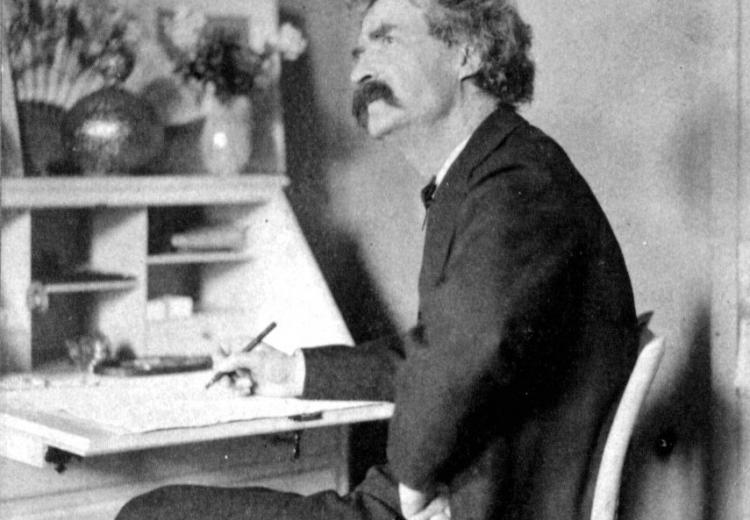Twain & American Humor

Mark Twain, pondering at his desk. c. 1890
Mark Twain and American Humor
Mark Twain | George Washington Harris | Nathaniel Hawthorne
Mark Twain
Mark Twain was the pseudonym of Samuel Clemens, one of America's most famous writers. Read his short story "The Celebrated Jumping Frog of Calaveras County" and explore these websites to learn more about how Samuel Clemens created the "character" of Mark Twain, author.
- "The Celebrated Jumping Frog of Calaveras County"
- Samuel Clemens as Mark Twain website
- 1906 New York Times article about Mark Twain and his white suit
After you read the story, think about the way that it is structured. Your teacher may have you try a variety of exercises to explore the structure of the story, including staging and acting out the story or using one of the tools listed below. Use the questions below to help you think about how the structure contributes to the story's comedic effect.
- Structuring "Jumping Frog" (PDF)
- How does this structure influence our perception of Jim Smiley?
- To what extent does he seem just a character in a story?
- To what extent does he seem realistic, a picturesque inhabitant of the Old West?
- To what extent does he seem a fantasy creation of the storyteller, Simon Wheeler?
- How do these perspectives combine in our response to Smiley as a comic protagonist?
- How does Simon Wheeler's voice influence our perception of Smiley?
- To what extent does Wheeler's picturesque speaking style help bring Smiley's story to life?
- To what extent does his distinctive style bring Wheeler himself to life as a comic character?
George Washington Harris
George Washington Harris was an "authentic comic genius" (Wilson and Ferris) whose work influenced later writers such as Mark Twain and William Faulkner. Harris and other southwest humorists who wrote in the 1830s through the 1860s, though considered low-brow at the time, are now recognized as foundational contributors to the humorist literary tradition. Read the Sut Lovingood story, "Mrs. Yardley's Quilting Party," by George Washington Harris and examine the story's structure.
This interactive map of the United States, via EDSITEment-reviewed Digital History, shows the outlines of states as they are added to the United States. To see this in action, drag the bar at the bottom through the timeline. Important moments in history are noted and annotated on the map.
Static maps via EDSITEment-reviewed Digital History:
- "1827 United States of America. Warr ca. 1827 201kb,"
- Westward Expansion 1815-1845
- Exploration and Settlement 1820-1835
- Exploration and Settlement 1835-1850
Additional maps available at the EDSITEment-reviewed National Parks Service: A Link to the Past:
- United States in 1830
- United States in 1860
- United States in 1861, showing Union and Confederate states
- How does each dialect style (Twain's and Harris') characterize the speaker?
- How does each influence our attitude toward the speaker?
- Is Sut Lovingood more or less appealing for the way he speaks?
- How does this structure influence our perception of Sut Lovingood?
- How does it position him in relation to the narrator and the literate, "civilized" world that the narrator represents?
- How does it reflect on the "folk" world for which Sut is the spokesman?
- Based on the story's structure, who is the target of Harris' humor?
- To what extent is Sut Lovingood the instrument of Harris' ridicule and to what extent the object of it? Is Sut a trickster like Jim Smiley of Mark Twain's "Jumping Frog" or, as Harris described him in the subtitle to his collection of Sut Lovingood stories, "a Nat'ral Born Durn'd Fool"?
Nathaniel Hawthorne
Born in 1804 in Salem, Massachusetts, and a descendant of a judge in the Salem Witch Trials, Nathaniel Hawthorne had an understandable fascination with the Puritan ancestry and history that surrounded him. His collection of stories, Twice-Told Tales, which includes "Dr. Heidegger's Experiment," with its sharp satire and refined narrative style, was published in 1837. Read about Hawthorne, read his story "Dr. Heidegger's Experiment," and consider whether or not the tale is darkly moralistic or satiric.
- Biography of Nathaniel Hawthorne and the Interactive Timeline (choose Life & Literary Career)
- "Dr. Heidegger's Experiment" by Nathaniel Hawthorne
The Narrator:
- Is there a role for Hawthorne's narrator in their dramatization of the story?
- Where does the narrator stand in relation to the action he describes?
- Is he the storyteller, like Simon Wheeler; an audience, like the narrators created by Twain and Harris; or simply an observer of the action, like Hawthorne's reader?
Dr. Heidegger:
- To what extent is Dr. Heidegger a satirist who "stages" this experiment to reveal his victims' weaknesses?
- How does the narrator compare to Dr. Heidegger? How do they differ? Do they reflect similar or different social circumstances?
(If you have read the stories by Mark Twain and George Washington Harris, also review these questions:)
- To what extent can he be compared to a storyteller like Simon Wheeler?
- To what extent can he be compared to a trickster like Jim Smiley or Sut Lovingood?
The Structure of the Story:
- How does the story's structure influence our perception of Hawthorne's characters? Do they seem like "storybook" characters? realistic? fanciful?
